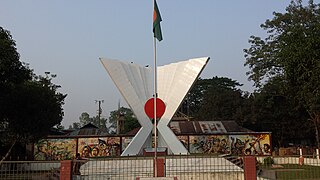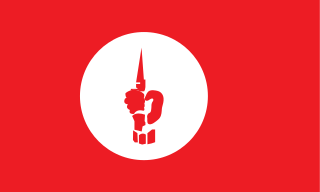
The Bangladesh Armed Forces are the military forces of the People's Republic of Bangladesh. They consist of the three uniformed military services: the Bangladesh Army, the Bangladesh Navy and the Bangladesh Air Force. The Armed Forces are under the jurisdiction of Ministry of Defence of the Government of Bangladesh, and are directly administered by the Armed Forces Division of the Prime Minister's Office. The President of Bangladesh serves as the Commander-in-Chief of the Bangladesh Armed Forces. Bangladesh has the third-largest defence budget in South Asia, The Bangladeshi military is the 37th strongest in the world and the third most powerful military force in South Asia. Border Guard Bangladesh and Bangladesh Coast Guard are under the jurisdiction of the Ministry of Home Affairs. during peacetime, but during wartime they fall under the command of Bangladesh Army and Bangladesh Navy respectively.

The Bangladesh Liberation War, also known as the Bangladesh War of Independence and known as the Liberation War in Bangladesh, was an armed conflict sparked by the rise of the Bengali nationalist and self-determination movement in East Pakistan, which resulted in the independence of Bangladesh. The war began when the Pakistani military junta based in West Pakistan—under the orders of Yahya Khan—launched Operation Searchlight against the people of East Pakistan on the night of 25 March 1971, initiating the Bangladesh genocide.

Mohammad Ataul Gani Osmani was a Bangladeshi military officer and revolutionary. His military career spanned three decades, beginning with his service in the British Indian Army in 1939. He fought in the Burma Campaign during World War II, and after the partition of India in 1947, he joined the Pakistan Army and served in the East Bengal Regiment, retiring as a colonel in 1967. Osmani joined the Provisional Government of Bangladesh in 1971 as the commander-in-chief of the nascent Bangladesh Forces. Regarded as the founder of the Bangladesh Armed Forces, Osmani retired as the first full general from the Bangladesh Army in 1972.

The Liberation War Museum is a museum at Agargaon in Dhaka, the capital of Bangladesh, which commemorates the Bangladesh Liberation War that led to the independence of Bangladesh from Pakistan.
The Battle of Boyra was a ground and aerial battle that was fought on 22 November 1971 between the India and Pakistan.
The Bangladesh Liberation War started on 26 March 1971 and ended on 16 December 1971. Some of the major events of the war are listed in the timeline below.
Operation Chengiz Khan was the code name assigned to the preemptive strikes carried out by the Pakistani Air Force (PAF) on the forward airbases and radar installations of the Indian Air Force (IAF) on the evening of 3 December 1971, and marked the formal initiation of hostilities of the Indo-Pakistani War of 1971. The operation targeted 11 of India's airfields and also included artillery strikes on Indian positions in Kashmir. The targets were the Indian Airbases of Amritsar, Ambala, Agra, Awantipur, Bikaner, Halwara, Jodhpur, Jaisalmer, Pathankot, Bhuj, Srinagar and Uttarlai and air defence radars at Amritsar and Faridkot.

Operation Jackpot was a codename for three operations undertaken by the Bengali Mukti Bahini in former East Pakistan against the Federation of Pakistan at the climax of the Bangladesh Liberation War.

The Al-Shams was a collaborationist anti-Bangladesh paramilitary wing of several Islamist parties in East Pakistan composed of local Bengalis and Muhajirs that along with the Pakistan Army and the Al-Badr, is accused of conducting a mass killing campaign against Bengali nationalists, civilians, religious and ethnic minorities during 1971. The group was banned by the government of Bangladesh, but most of its members had fled the country during and after the Bangladesh Liberation War, which led to Bangladesh's independence.
Hemayet Bahini was a guerrilla militia force of Bangladesh in the Bangladesh Liberation War of 1971. This small force was known by the name of its leader and organizer Mohammad Hemayet Uddin Bir Bikrom.

Bangladesh's military history is intertwined with the history of a larger region, including present-day India, Pakistan, Nepal, Bhutan and Myanmar. The country was historically part of Bengal – a major power in South Asia and Southeast Asia.

The Battle of Kamalpur, launched against the Pakistan Army is one of the most significant military engagements fought by the Mukti Bahini in 1971 during its war of independence from Pakistan. The Pakistani Army set up a military camp at Kamalpur which was attacked by 1st East Bengal Regiment of Z Force several times. The first attack was made on June 12, and a second attack was made on July 31, 1971, also another attack at 22 October 1971 and in total, there were 18 battles in Kamalpur.

Prior to Bangladesh Liberation War in 1971, India had no plans for large scale military action in East Pakistan. Since the Sino-Indian War of 1962, the primary objective of the Indian Army Eastern Command was the defence of the Indian northern and eastern borders, defending the "Shiliguri Corridor", and on combating insurgencies raging in Mizoram, Nagaland, Manipur and the Naxalites in West Bengal.

The Mukti Bahini, also known as the Bangladesh Forces, was the guerrilla resistance movement consisting of the Bangladeshi military, paramilitary and civilians during the Bangladesh Liberation War that transformed East Pakistan into Bangladesh in 1971. They were initially called the Mukti Fauj.

Z Force, also known as the Tura Brigade, was the first military brigade of Bangladesh Forces, formed during the Liberation War of Bangladesh in 1971 under Major Ziaur Rahman along with the consent of the revolutionary government of Bangladesh in exile. The brigade was formed with the 1st, 3rd and 8th Battalion of East Bengal Regiment on 7 July 1971. It is the first ever complete brigade formed during the Liberation War of Bangladesh in 1971.

Muktijoddha Sangsad a non-political welfare association of the combatants during the Bangladesh Liberation War formed on 13 February 1972. The organisation has a football club, Muktijoddha Sangsad KC, named after itself.
Golam Helal Morshed Khan is a retired major general of the Bangladesh Army and a veteran of the Bangladesh Liberation War. He was awarded Bir Bikrom, the third highest gallantry award, for his actions in the war. He participated in the 1996 Bangladeshi coup d'état attempt.
Akbar Bahini was a volunteer force during the Bangladesh Liberation War. Akbar Hossain Miah was the Chairman of Srikul Union in Sreepur PS of Magura District. Immediately after the outbreak of war, Akbar Hossain devoted himself in organising a group of fighters. The majority of the members of Akbar Bahini were extracted from amongst the locals of Sreepur area, but, also included members of the East Pakistan Rifles. Akbar Hossain Miah, formed a group of fighters called 'Akbar Bahini'. Akbar Hossain was the commander, and Mollah Nabuwat Ali was its deputy commander.
Gafur Bahini was a militia that was formed in the beginning of the Bangladesh Liberation War. Abdul Gafur, Mohiuddin Manik and Benilal Das Gupta took an initiative to create a force, that would fight Pakistani troops in Barisal, It later on merged with the Force of Captain Shahjahan.

The 1968–1971 East Pakistan communist insurgency was an armed conflict between several communist groups and the Pakistani government for the independence of East Pakistan, it was also later part of the Bangladesh Liberation War in 1971.












